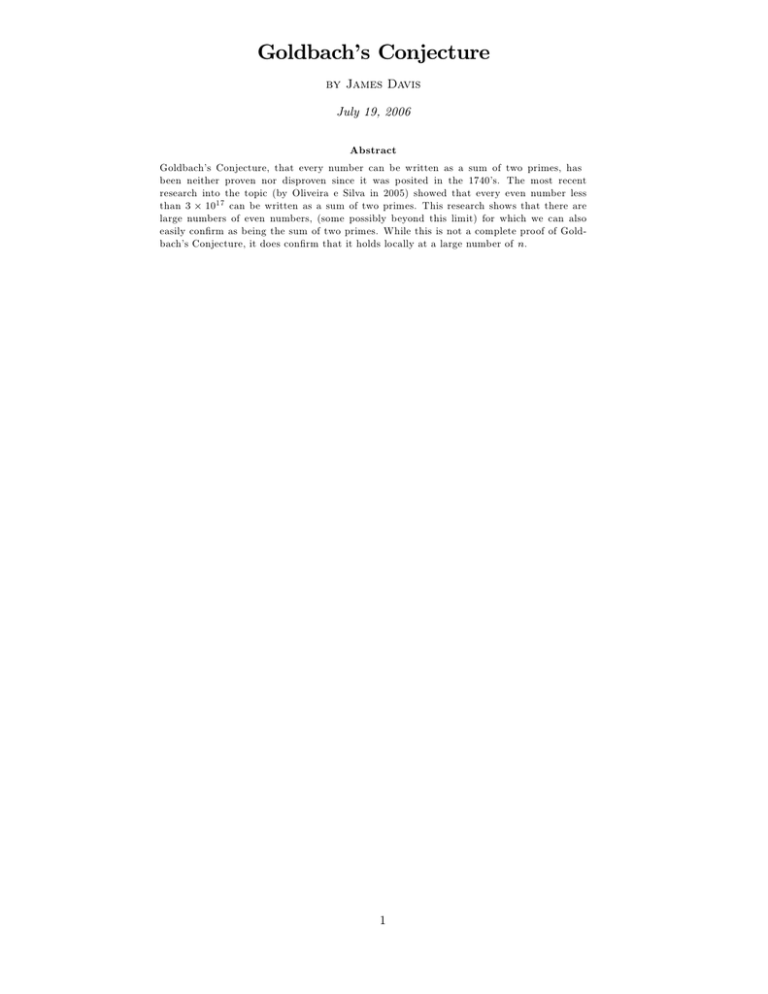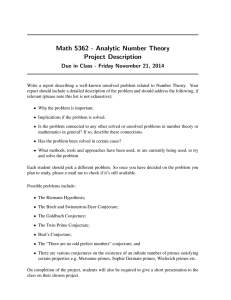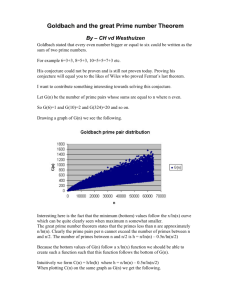Goldbach’s Conjecture by James Davis July 19, 2006
advertisement

Goldbach’s Conjecture
by James Davis
July 19, 2006
Abstract
Goldbach’s Conjecture, that every number can be written as a sum of two primes, has
been neither proven nor disproven since it was posited in the 1740’s. The most recent
research into the topic (by Oliveira e Silva in 2005) showed that every even number less
than 3 × 10 1 7 can be written as a sum of two primes. This research shows that there are
large numbers of even numbers, (some possibly beyond this limit) for which we can also
easily confirm as being the sum of two primes. While this is not a complete proof of Goldbach’s Conjecture, it does confirm that it holds locally at a large number of n.
1
2
Section 1
1 Current Research
Before we continue, there are two important definitions we need to posit.
Definition 1. Given a number, n, we may say that any number m less than n is a totive of n
iff m ∤ n.
Definition 2. φC (n) is the number of composite totives of n.
Theorem 3. φC (n) < π(n) implies that n can be written as a sum of two primes.
Proof. In general, even numbers that can be written as the sum of two primes do not have a
unique way of doing so; therefore, it is useful to define an algorythm for writing such an
algorithm.
Let P be the set of all primes
Now define the sets,
PN (n)
Now find
m
4P
P0(n)
4 {p ∈ P|p < n}
N −1(n) − {max [PN −1(n)]}
(1)
∀N ≥ 1
(2)
4 min [{N ∈ N|(n − max [P
(3)
n = max [Pm(n)] + (n − max [Pm(n)]))
(4)
N (n)]) ∈ P}]
n may then be written as
Suppose there exists a D that cannot be written as a sum of two primes. Then
∀n ∈ N (D − max [Pn(D)]) P
(5)
Then clearly for any prime pi < D, D − pi is a composite number.
Another form of this assertion is that for any D that cannot be written as the sum of two
primes, for every prime pi there exists a composite ci (both of which are less than D), such that
D = p i + ci
(6)
We may observe that pi + ci = D implies that pi = D − ci. Now, if D and ci shared a common
factor (Say, for example, D = κ d and ci = κ ki), then we could write
pi = κ d − κ ki = κ (d − ki)
(7)
But this implies that pi is not prime.
Therefore, ci and N can have no common factors (Because ci is less than N , we can say that
ci is a totive of N ). Therefore, this implies that any D (even) that cannot be written as a sum
of two primes must satisfy:
φC (D) ≥ π(D)
(8)
If D did not satisfy this, then there would not be enough possible ci to go with every pi. Therefore, any number for which the negation of (8) is true can be written as a sum of two primes. 3
Future Research
2 Future Research
Unfortunatly, this relationship does not prove Goldbach’s Conjecture, it only shows that
any ‘disproofs’ will likely be isolated cases.
Research is continuing towards the following:
Theorem 4. There exists no n such that φC (n + m) ≥ π(n + m) for all m ∈ N.
This appears to be true because we can construct large k with very low φC (k), but I am not
certain I have obtained a proof at this time.
Proof of theorem 4 would show that there are infinitly many even numbers that can be
written as a sum of two primes.
Theorem 5. Goldbach’s Conjecture
It is not hard to see that because of the relation D = pi + ci we are guaranteed that if D
D
D
D
D
cannot be written as a sum of two primes either pi < 2 and ci > 2 or pi > 2 and ci < 2 .
D
Because primes are not distributed symmetricly about 2 this approach (and perhaps one with
slightly smaller bounds) could show that even if φC (D) ≥ π(D) the totives of D will not be distributed in such a way to allow D to be written as D = pi + ci for all pi.
Proof of theorem 5 is the ultimate goal for the research.









